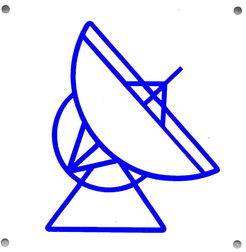Galaxy Trail
Complementing two earlier astronomical trails at the Effelsberg radio telescope, labelled Planetary Trail and Milky Way Trail, we have built a third trail, called Galaxy Trail in order to extend the cosmic distance scale to the edge of the Universe. The Galaxy Trail comprises a total of 14 stations leading from our Milky Way Galaxy along its neighbour, the Andromeda Galaxy (M 31), to extremely distant objects like the galaxy SDSS J1148+5251. Its emission takes almost 13 billion years before reaching our telescopes. The Galaxy Trail starts east of the 100 m radio telescope in the forest and leads to a nearby hut (“Martinshütte”) which is reached after 2.6 km distance including a steep climb through the forest.

Martinshütte of the Kirchsahr municipality, the final destination of the Galaxy Trail.
The Galaxy Trail was built as a cooperative project between the Max Planck Institute for Radio Astronomy and the Freundeskreis Sahrbachtal. The logo for the Galaxy Trail is a blue telescope on white background:

Here a link with trekking information on the Galaxy Trail:
The information presented on the 14 stations of the Galaxy Trail is compiled in the following.
The Galaxy Trail at the Effelsberg Radio Observatory runs from the 100 m radio telescope to the Martinshütte, a small hut belonging to the nearby Kirchsahr municipality. The walk is scaled 1 : 5 x 1022 (1 : 50 sextillions) meaning 5 billion light years per kilometre or a million light years per 20 centimetres. Our home galaxy, the Milky Way, is only at a distance of 50 centimetres from its large neighbour, the Andromeda galaxy, corresponding to a real distance of 2.5 million light years.
On a total length of about 2.6 kilometres (exactly 2570 metres) there are 14 stations describing a journey from our position in the Milky Way to sources at the edge of the known universe, their radiation reaching us over a light travel time of more than 13 billion years.

